Ellie Andrews (hemandrews@ucdavis.edu) and Sire Kassama, PhD candidates at UC Davis in the Horticulture & Agronomy graduate group. All photographs by Ellie Andrews.
 New studies show that almond hulls and shells release potassium into the soil when they are surface applied as organic matter amendments in the orchard. Potassium release from hulls and shells is strongly driven by water application and is not initially limited by decomposition rate. This practice can help increase soil exchangeable potassium with benefits to July leaf potassium values. In the long term, hull and shell amendments could be used with other soil health practices such as reduced soil disturbance to build soil organic matter content while reducing dust and erosion. Hulls and shells are often locally available and can be returned to the orchard at low costs.
New studies show that almond hulls and shells release potassium into the soil when they are surface applied as organic matter amendments in the orchard. Potassium release from hulls and shells is strongly driven by water application and is not initially limited by decomposition rate. This practice can help increase soil exchangeable potassium with benefits to July leaf potassium values. In the long term, hull and shell amendments could be used with other soil health practices such as reduced soil disturbance to build soil organic matter content while reducing dust and erosion. Hulls and shells are often locally available and can be returned to the orchard at low costs.
High potassium concentrations set hulls and shells apart from other organic matter amendments. For many almond growers, potassium (K) makes up a large portion of fertilizer costs. Potassium export in almond fruits can vary from 236-347 lb/ac K (Muhammad et al. 2015). However, it is important to consider K contribution from the soil: if soil exchangeable potassium is between 100-150ppm, K application of approximately 100 lb/ac can satisfy crop K demand (Muhammad et al. 2018). Almond growers in the Sacramento Valley typically use around 400 lb/ac K2SO4 annually for mature orchards (Sumner et al. 2019).
Returning hulls and shells to the orchard could help cover required K inputs. The total amount of K released depends on the application rate, initial K concentration of the amendments, and total rainfall and irrigation. Three commercial almond orchards near Woodland, Davis, and Tracy are hosting field trials with hull and shell amendments. In these three separate field trials with different hull-shell materials and irrigation systems, soil exchangeable potassium was significantly higher under hull-shell amendments after approximately 1.5-2 inches of water (irrigation and rainfall). Each amendment treatment was applied to entire rows of at least 40 trees and compared to a control row with no amendments. Treatments were replicated in randomized complete block designs with 4 blocks each containing all treatments. Since the field sites differed in soil type (clay, silty clay loam, and loam), irrigation approach (two drip, one micro-sprinkler irrigated orchard), and nutrient management approaches, each field site was approached as a unique case study with different application rates that were tailored to meet different growers’ interests and goals. Application rates ranged from 2.5-9.5 tons/ac. At each site, growers’ mineral potassium application was consistent across all treatments.
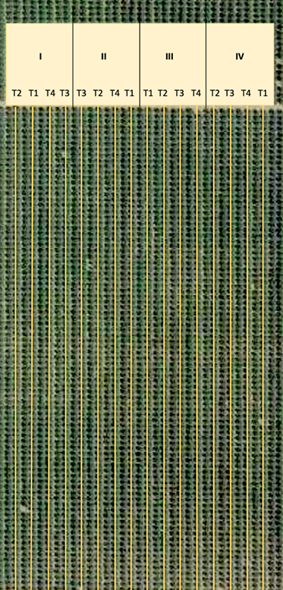
Experimental design map. Each yellow bar represents a Nonpareil row that received a treatment. Each treatment was randomized and replicated in four blocks within areas of the orchard that had a consistent soil type.
Approximately 35-70% of total K in hull-shell materials was released within the first 3 inches of water application, which significantly increased soil exchangeable K under amendments at all sites. After this initial sharp release curve, K release was more gradual. Based on these trials so far, total K release can vary between 77-95% from Fall application until the following summer. These findings are supported by many prior studies that conclude water application is the primary driver of K release out of crop residues into the soil, making K available for plant uptake (Andrews et al. 2021).
These findings can help growers estimate how much potassium is likely to be made available in the soil from an application of hulls, shells or a mix of hulls and shells. For example, an application of 5 fresh tons of hull-shell mix with 2.37% K and 13% moisture content has the potential to supply as much as 208 lb of K (250 lb K2O). To calculate the K2O equivalent and compare with fertilizers, it’s important to know that every pound of K equals 1.2 lb K2O.
2.37% K * 0.01 * 2000 lb hull-shell mix = 47.4 lb K per ton of hull-shell mix, where 0.01 is a conversion factor allowing us to use %K to find lb K in 1 ton of mix
47.4 lb K per ton x 5 tons x 0.87 dry weight = 206 lb K x 1.21 = ~250 lb K2O, where 0.87 is the fraction of dry weight since moisture content is 13%
If 85% of this total K is released from the amendments into the soil total within a season, that amounts to around 175 lb K (212 lb K2O).

Table 1. Initial Average Potassium in Hull, Mix, and Shell Amendments. Source: %K averages from Andrews unpublished data, 3 field sites, 2019-2022.
Growers can adjust application rate to meet site-specific K targets, such as increasing soil exchangeable K levels, matching the amount of K exported at harvest, or increasing July leaf K levels. See Table 1 below for differences in July leaf K concentration between control trees and trees amended with hulls and shells. So far, none of the three field trials have found any effects of potential soil microbial nitrogen immobilization on July leaf nitrogen. Avoiding extremely high rates of these amendments might be advisable to reduce the potential of high K uptake competing with magnesium uptake. After one season, shells decompose ~20-30% by dry weight, while hulls and hull-shell mixes tend to decompose ~40-50%. Trash in yield samples at harvest was weighed and separated to compare hull-shell trash vs. all other trash. Hull-shell trash only comprised approximately 2.4-10.6% of all yield sample trash—hull-shell amendments remaining in the alley likely filter out of yield samples at pick-up due to their light weight and small size.
Applying hulls and shells as amendments on the soil surface above tree roots can increase soil exchangeable potassium in the tree row. Hulls and shells have different bulk density, K concentration, release characteristics, and interactions with soil properties than mineral K fertilizers. Existing recommendations suggest mineral K can be banded in a line.
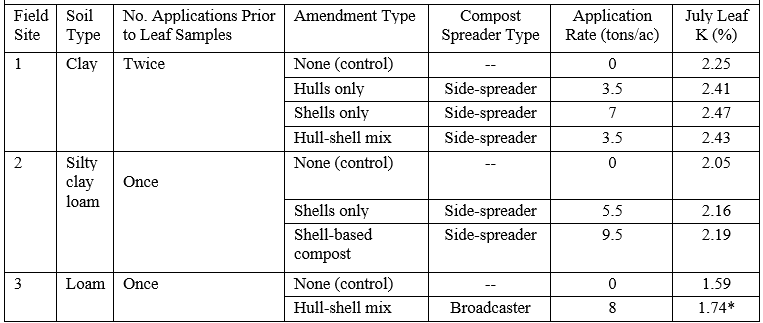
Table 2. Review of July leaf K results from three field trials sampled in 2021. Trees amended with a hull-shell mix in loam soil at 8 tons/ac showed significantly higher (*) July leaf K compared to control trees. July leaf K increased at other sites to a smaller degree. Typically, 1.4-2.7% K is a sufficient range for almond July leaf K values (FREP CDFA).
These trials indicate almond hull-shell amendments on the soil surface release potassium under water application (both drip and micro), increase soil exchangeable potassium levels, and increase July tree leaf potassium values to varying degrees. This research is ongoing: researchers are investigating the short and long-term effects of this practice on K cycling, soil-plant water dynamics, soil health, and crop productivity. We still need to answer questions regarding whether these amendments provide a mulching effect to maintain soil moisture storage and reduce soil surface evaporation compared to bare soil, and potential associated effects on tree water status over time. We are also investigating the effects of this practice on components of soil health, including shifts in soil microbial community composition and function, potential improvements in soil fertility metrics (in addition to potassium), and potential improvements in soil physical properties that benefit soil water and nutrient retention. Further long-term research is needed to understand how to best use this practice to increase yield in different contexts, such as in potassium-deficient orchards.
Overall, almond hulls and shells are around 70% of crop weight leaving the field at harvest (Almond Almanac, 2020). After processing, billions of pounds of these materials are leftover each year even after some are sold to the dairy industry. Instead of leaving the field for good, applying hulls and shells recycles K value back to the orchard. Nearby orchards can be a convenient outlet for processors that need a destination for stockpiles of hulls and shells, which could help prevent biomass buildup and mulch fires. These materials can be surface applied annually in the Fall over tree roots for nutrients or in alleys as a mulch. While this practice is compatible with on-ground harvest, off-ground harvest equipment could help maintain this mulch layer on the soil surface for longer time periods, release a higher fraction of amendment K, and build an organic layer on the soil surface. Hulls and shells can be used together with other soil health practices, such as compost applications, cover crops, and whole orchard recycling. Side-spreading hulls and shells can help concentrate K over tree roots, while broadcasting hulls and shells can provide carbon inputs across the entire soil surface including the alley. Growers can adjust application strategies to meet the needs of their orchard.
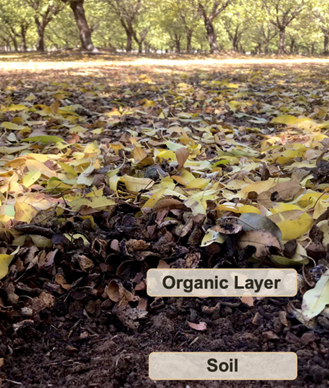
The organic layer in an almond orchard maintained with off-ground harvester: hull and shell amendments, compost, and leaf litter. Fall 2021.
Funding for this research was provided by a grant from the Western SARE Research & Education Program led by Drs. Sat Darshan Khalsa and Patrick H. Brown in the Department of Plant Sciences, UC Davis.

References
Almond Board of California. 2020. Almond Almanac. Modesto, California. Document #2020IR0296.
Andrews, E. M.; Kassama, S.; Smith, E. E.; Brown, P. H.; Khalsa, S. D. S. 2021. A Review of Potassium-Rich Crop Residues Used as Organic Matter Amendments in Tree Crop Agroecosystems. Agriculture, Special Issue “Organic Management and Productivity of Tree Crops” 11 (7).
CDFA. 2022. California crop fertilization guidelines. California Department of Food and Agriculture, Fertilizer Research and Education Program, and University of California Davis.
https://www.cdfa.ca.gov/is/ffldrs/frep/FertilizationGuidelines/Almonds.html
Sumner, D.A., Buchner, R.P., Niederholzer, F., Jarvis-Shean, K.S., Lightle, D.M., Symmes, E.J., Milliron, L., Stewart, D. 2019. Sample costs to establish an orchard and produce almonds, Sacramento Valley. University of California Agriculture and Natural Resources Cooperative Extension, Agricultural Issues Center, UC Davis Department of Agricultural and Resource Economics.
Muhammad, S., Sanden, B., Lampinen, B., Saa, S., Siddiqui, M., Smart, D., Olivos-Del Rio, A., Shackel, K., Dejong, T., & Brown, P. 2015. Seasonal changes in nutrient content and concentrations in a mature deciduous tree species: Studies in almond (Prunus dulcis (Mill.) D. A. Webb). European Journal of Agronomy, 65.


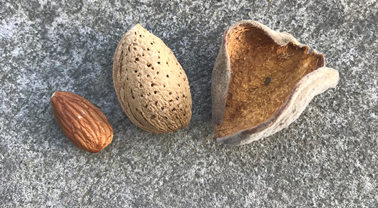
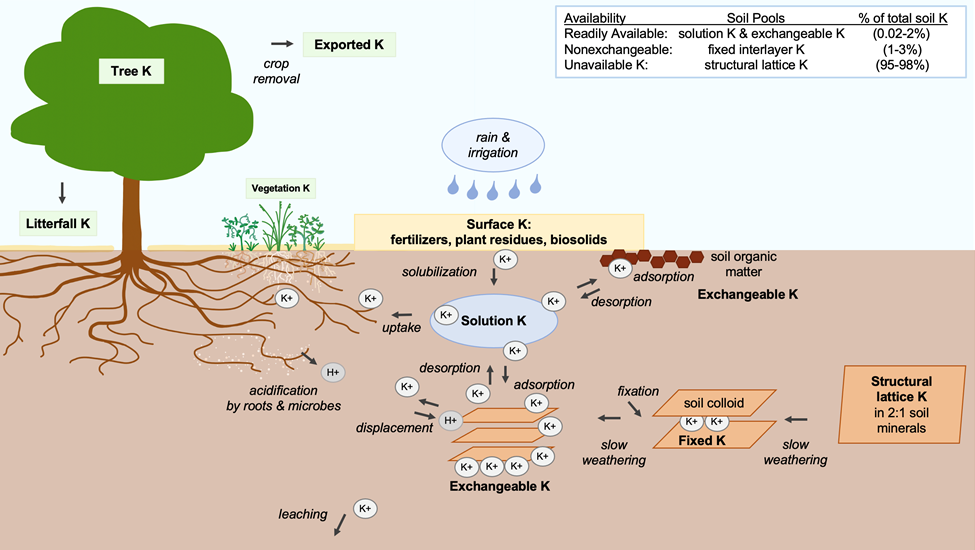


Leave a Reply